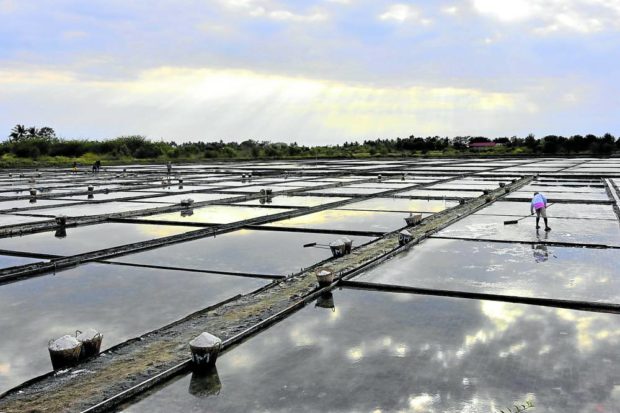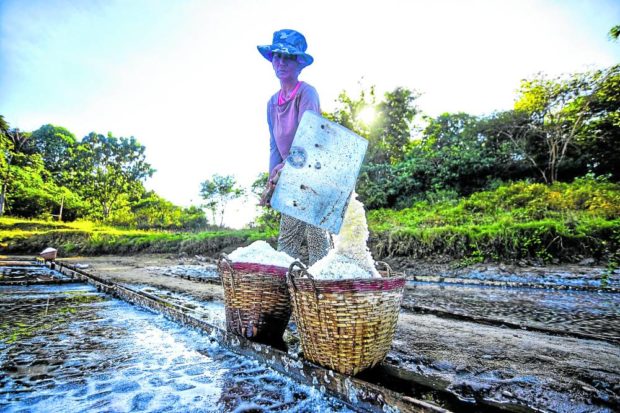Pangasinan salt farmers feel pinch of ailing industry

COMMUNITY LIVELIHOOD | Pangasinan, whose name is derived from the local phrase “panag asinan” (where salt is made), is among the provinces producing salt in the country. But areas covered by its salt farms, like this one photographed in 2018 at Barangay Hermosa in Dasol town, have been diminishing in recent years, resulting in a continuous decline in production. (Photo by WILLIE LOMIBAO / Inquirer Northern Luzon)
LINGAYEN, Pangasinan, Philippines — Lizel Cacayuran, 37, remembers toiling away under the sweltering heat, raking the salt beds before gathering and placing the mounds of white crystals into bamboo baskets.
Cacayuran, a mother of three teens, had to endure this backbreaking work almost every day for a year to make ends meet. “My hands would really hurt at the end of the day,” she told the Inquirer.
While her job at a salt farm in the coastal village of Pangapisan in Alaminos City was already particularly grueling, Cacayuran’s pay was way below the average daily minimum wage.
“It’s that kind of job that I don’t want my children to do,” she said, noting that she had to quit after a year.
But her father, Eduardo Rapelo, 56, endures the backbreaking routine at the same salt farm, as poverty and his lack of education have forced him to stay.
Article continues after this advertisement“My father really had no choice, so he won’t leave the salt farm just yet,” Cacayuran said.
Article continues after this advertisementCacayuran’s husband, Zaldy, a village councilor who is in charge of the community’s fisheries concerns, said salt production in their barangay had already slowed down, owing to the heavy rains in the area this year.
According to local salt farmers, the industry usually comes alive during the dry season, between March and mid-May.
But during the rainy season, the farms are filled with water and temporarily become fishponds to grow “bangus” (milkfish).
In another village of Alaminos, a 50-hectare farm has been idle for 10 years due to a land dispute, Alex Baybon of the city agriculture office said.
Challenges
The hardship of Cacayuran’s family and that of other farmers mirrors the challenges faced by the province’s salt industry, which is also beset by slow technological development, resistance to innovation, land conversions, changing weather patterns, and lack of government support.
In recent weeks, the status of local salt production, or the lack of it, has once again piqued the interest of national officials who alleged there was a shortage of the commodity.
The country’s salt production peaked during the 1970s, but started to decline in the 1980s through its worst in the 1990s, said Dr. Paulo Cenas, Pangasinan State University (PSU) vice president for research and extension, who conducted a study on the Philippine salt industry.
A number of factors have contributed to the declining yield and the eventual massive importation of salt, he said.
For one, the younger generation has started to steer clear of salt farming due to its labor-intensive nature that does not pay well, Cenas said.
Salt farms, he said, are also being converted into housing and industrial areas, displacing salt makers who are only leasing the farms from the government through fishpond lease agreements.
“Besides, their facilities are already depreciated, and salt makers lack the capital to reinvest, a situation worsened by a lack of support from the national government,” Cenas told the Inquirer.
Climate change, or the La Niña scourge characterized by an extended rainy season, is also disabling the salt producers’ ability to operate their salterns (salt beds).

TRADITIONAL PRODUCTION A salt farm worker at Barangay Telbang in Alaminos City, Pangasinan, fills a bamboo basket with mounds of salt using a wooden rake. Salt making is among the major sources of livelihood in the province. (Photo by WILLIE LOMIBAO / Inquirer Northern Luzon)
Competition
When the country joined the World Trade Organization-General Agreement on Tariffs and Trade in 1994, the industry took a turn for the worse.
Local farmers began seeing thousands of tons of salt from other countries entering the local market.
According to Cenas and other industry stakeholders, there is no law that charts the direction of the local salt industry, much less to protect it.
They said the Asin Law, or the Act for Salt Iodization Nationwide (Republic Act No. 8172), introduced during the administration of then President Fidel V. Ramos in 1995, had even reduced salt production in the country.
The law requires all producers of food-grade salt to iodize the salt that they produce, manufacture, import, trade or distribute for human and animal consumption. All locally produced salt is meant for human and animal consumption and has to be iodized, while imported products are for industries and are exempted from the law.
Most salt makers did not have the means to buy the costly equipment for iodization, and potassium iodide (used to iodize salt) is expensive, Cenas said.
Since farmers could not market plain salt, they were marginalized and most stopped production, he added.
‘Orphan’
While salt is an important mineral in Filipinos’ daily lives and to the manufacturing industry, agriculture, and other sectors, it is actually an “orphan” with no agency tasked to oversee it, unlike other commodities, such as sugar, tobacco, and even carabao, according to Nestor Domenden, the Bureau of Fisheries and Aquatic Resources (BFAR) officer in charge.
“The industry has been beset with challenges over the years and, thankfully, in recent weeks it is finally getting the attention it deserves, with the BFAR being in charge of its management,” he said in a separate interview.
Domenden said the BFAR, historically, was under the Department of Environment and Natural Resources (DENR), then the Ministry of Natural Resources under the administration of President Ferdinand Marcos Sr. But during the presidency of Corazon Aquino, fish production was transferred to the Department of Agriculture (formerly the Ministry of Agriculture and Food), which issues the fishpond lease agreement.
According to Domenden, artisanal salt farms are under a fishpond lease agreement, as these areas are used as fishponds during the rainy season and as salterns during the dry season.
Strategic commodity
“But the commercial salt farms are still under the fishpond lease agreement of DENR,” he said.
“But Republic Act No. 8550, or the Philippine Fisheries Code, was enacted in 1998 and it defined salt as one of the aquatic resources, and thus the sector must be managed by the BFAR,” Domenden said.
Salt was not even considered a commodity, he noted.
At a recent Ilocos Regional Development Council meeting in La Union province, Domenden, as chair of the economic development subsector, endorsed salt as a strategic commodity of the region, a move that was approved by the council.
“Since it is now a strategic commodity with economic importance, the private sector can invest in production and in research and development,” Domenden said.
Top producers
According to Cenas, the four provinces of the Ilocos region are ideal for salt production as these have a Type I climate. Six other provinces facing the West Philippine Sea also have a Type I climate—Zambales, Bataan, Mindoro, Marinduque, Antique and Palawan.
Type I climate means pronounced seasons and predictable—dry from November to April, when salt is produced, and wet during the rest of the year. Other provinces, like those facing the Pacific Ocean and Mindanao, have a shorter dry season and therefore can produce only a smaller volume.
Pangasinan, whose name is derived from the local term for salt (“asin”), is the largest salt producer in the country, with production at 60,000 metric tons annually, according to data collected by local salt industry stakeholders.
Mindoro Island ranked second at 45,000 MT, followed by Bulacan, which contributed 5,000 MT.
Pacific Farms, the largest salt farm in the country, used to contribute 25,000 MT a year to the country’s production, but it stopped operations last year after the DENR did not renew its contract for a fishpond lease agreement.
“But these are just estimates from the private sector, as we don’t have a government agency in charge of the commodity,” Cenas said.
According to industry experts, the country imports 93 percent of its salt requirements, or 550,000 MT per year.
Kabayan Rep. Ron Salo, in House Bill No. 1976 aiming to revive the local salt industry, said the country’s salt supply comes from Australia (72 percent), China (18.7 percent), Thailand (4.2 percent), and New Zealand (2.39 percent).
“This is ironic because the Philippines has 36,000 kilometers of coastline,” Domenden said.
According to Cenas, the country needs 40 farms the size of Pacific Farms in Bolinao, Pangasinan, to be self-sufficient in salt.
If each of the 40 farms could produce 20,000 MT a year, that would be a “whopping” 800,000 MT each year, Domenden said.
PSU, which has taken a lead role in salt research and development, is organizing a salt industry congress in November.
The gathering, Cenas said, will provide an avenue to disseminate current policy developments and technologies geared toward elevating salt production in the country.
The country’s salt industry may not be dying yet, but it needs all the government’s intervention to keep it sustainable for the country to be less dependent on importation, Domenden said.
RELATED STORIES
Gov’t working ‘double time’ to boost salt industry
Department of Agriculture pushes boost to salt making